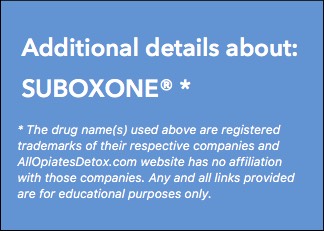Rapid Suboxone Detox under sedation is a medical detoxification treatment offered by All Opiates Detox for patients dependent
on Suboxone.
When MAT (medication assisted treatment) with Suboxone is used for the opioid-dependent patient, the opiate buprenorphine portion attaches to the opioid Mu receptors dependent on opiates. By this replacement therapy, the patient is still dependent on opiates. Basically, it is trading one opiate for the other. The patient will go through withdrawals when Suboxone is discontinued. Patients wanting to be opiate free reach out to us. We detox all opiates, rather than substituting one opiate with
another opiate.
Aftercare consisting of the Naltrexone opiate blocker, psychotherapy, and 12 step programs are recommended to ensure long-term abstinence and success.
CLICK ON ANY IMAGE BELOW TO WATCH VIDEO
Painless Suboxone Detox
Suboxone is used as an opiate agonist therapy for the treatment of opiate dependence.
Talk to us about family members and financing (800) 458-8130
Suboxone DETAILS
Suboxone is used as an opiate agonist therapy for the treatment of opiate dependence. It is a semi-synthetic opioid derived from thebaine of the poppy seed. Suboxone is a combination of the opiate buprenorphine and the opiate blocker naloxone. The purpose of combining it with naloxone is to prevent intravenous injection of Suboxone. It is the most widely used trade name of the buprenorphine. It was the first oral disintegrating tablet available with the buprenorphine-naloxone combination. After the pills went generic, Suboxone became available in the sublingual film, strip form. Later other combinations under trade names Zubsolv, Bunavail, Butrane became available. Suboxone starts to work about 30 minutes after sublingual administration, with maximum effects one to two hours later. The half-life is prolonged and varies between 24-60 hours. It is an opioid.
Suboxone SIDE EFFECTS
Suboxone can cause nausea, vomiting, drug withdrawal syndrome, headache, sweating, mouth numbness, constipation, tongue pain and redness of the mouth, attention problems, palpitation, reduced sleep, and decreased libido. Intoxication can also happen, especially when mixed with benzodiazepines.
Suboxone OVERDOSE
Taking benzodiazepines, sedatives or drinking alcohol while on Suboxone can result in overdose. Suboxone overdose symptoms include cold, clammy skin, coma, fainting, hypotension, sleepiness and sluggishness, slow, shallow breathing, respiratory depression, and death.
Suboxone WITHDRAWALS
Suboxone is a long-acting opioid, so withdrawals start several hours to days after its discontinuation. Suboxone withdrawals are more severe than some of the potent opiates. Withdrawals include nausea, vomiting, hot-cold flashes, restlessness, leg cramps, muscle jerking, anxiety, and sweating. Insomnia usually lasts several weeks to months. It is withdrawals that keep the patient going back to the use of opiates and consequently unable to break the cycle of addiction.
Suboxone ABUSE
When opiate agonist therapy with Suboxone is used for the opioid-dependent patient, it is done to satisfy the need of the opioid Mu receptor that is dependent on opiates. By this replacement therapy, the patient is still dependent on opiates. When Suboxone is discontinued, the withdrawal syndrome will start.
Suboxone is abused in several ways. Few patients have reported injecting Suboxone. Some patients report a “high” with its use. Suboxone is used by some patients to prevent withdrawals when they are not able to find their opiate of choice.
Painless, Rapid 3-Day Opiate Detox
Suboxone is used as an opiate agonist therapy for the treatment of opiate dependence.
Talk to us about family members and financing (800) 458-8130









